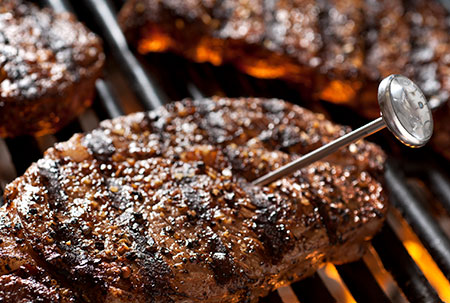Avoid food-borne illnesses during your wilderness retreats
Wildlife encounters are part of what make camping trips and picnics memorable: pelicans splash-landing in a lake, deer grazing in a meadow, a bear doing whatever, just as long as it’s at a very safe distance.
The same cannot be said about any microscopic creatures that might crash your party. We’re talking Salmonella on chicken, Listeria in a ham sandwich, rare instances of E. coli on leafy greens, and any other bug that might make an outing unforgettable for entirely the wrong reasons.
How do you get the good without the bad? First, you don’t let food safety issues frighten you, says NAIT food and catering services sous chef Roberto Valencia Robles (Baking ’11, Culinary Arts ’12). “There’s bacteria everywhere,” he says of the great outdoors. “It’s not an operating room.”
Then, you follow these 10 simple tips – and have a great trip.
1. Wash in advance. If you’re not sure there will be clean water at your camp or picnic site, wash produce in advance. “If you dry them completely, they’ll last longer,” says Valencia. That goes for lettuce, too. Place leaves between fresh paper towels once dry.
2. Also in the absence of clean water, pack hand sanitizer, he recommends.
3. Avoid the danger zone. Store perishables at temperatures lower than 4 C (40 F). Above that and up to about 60 C (140 F), bacteria can grow to sickening amounts.
4. Mind the hierarchy meats. Some are simply better at staying fresh. Steak is at the top, followed by chicken and fish, then ground beef, which has more surface area to harbour microbes, Valencia points out.
5. Pack everything separately. Putting different meats in one container may be convenient, but it’s a greater risk for cross-contamination, even if the meat is individually wrapped. It's a problem because not all meats need to be cooked to the same final, bacteria-killing temperature.
6. Vacuum seal it. Most microbes can’t grow without oxygen, making a vacuum sealer a great investment for the avid camper and picnicer.
7. Layer the cooler. Dumping a bag of ice on top of a stack of containers isn’t going to cut it. Pour in some cubed ice or lay down ice packs, add a layer of food, cover with ice and repeat. Consider freezing meats in advance. “As long as the cooler is full of ice, food will stay fresh three to four days,” says Valencia.
 8. Eat pickled things. “You can pickle anything,” says Valencia. While you can take that under advisement, the sous chef points out that canned food doesn’t need to be kept cold, freeing up valuable cooler space.
8. Eat pickled things. “You can pickle anything,” says Valencia. While you can take that under advisement, the sous chef points out that canned food doesn’t need to be kept cold, freeing up valuable cooler space.
9. Cook meat thoroughly. A rare steak needs to reach at least (54 C) 130 F; for fish, it’s 63 C (145 F); chicken has to hit 75 C (165 C) to be safe. Packing a meat thermometer doesn’t take up much room and is far preferable to dealing with the consequences of improperly prepared food.
10. Stash your leftovers. Keeping with recommendations from Alberta Health Services, Valencia says that you can keep cooled, cooked food in a cold cooler for about three days – or the length of a glorious summer long weekend.
Symptoms of food poisoning
Think something's gone wrong with your al fresco dining adventure? Alberta Health Services says that if you and other people in your group experience similar symptoms, it might be something you ate. Those symptoms may include
- diarrhea
- feeling sick to your stomach
- vomiting
- stomach cramps
- high fever
- blood in your stool
Treatment includes rest and plenty of fluids to prevent dehydration. If symptoms persist beyond two or three days, see a doctor.